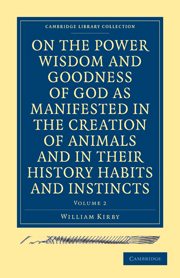Book contents
- Frontmatter
- Contents
- EXPLANATION OF PLATES
- CHAP. XIII Functions and Instincts. Cirripedes and Crinoïdeans
- CHAP. XIV Functions and Instincts. Entomostracan Condylopes
- CHAP. XV Functions and Instincts. Crustacean Condylopes
- CHAP. XVI Functions and Instincts. Myriapod Condylopes
- CHAP. XVII Motive, locomotive and prehensory organs
- CHAP. XVIII Instinct in general
- CHAP. XIX Functions and Instincts. Arachnidans, Pseudarachnidans, and Acaridan Condylopes
- CHAP. XX Functions and Instincts. Insect Condylopes
- CHAP. XXI Functions and Instincts. Fishes
- CHAP. XXII Functions and Instincts. Reptiles
- CHAP. XXIII Functions and Instincts. Birds
- CHAP. XXIV Functions and Instincts. Mammalians
- CHAP. XXV Functions and Instincts. Man
- CONCLUSION
- Index
- Plate section
CHAP. XV - Functions and Instincts. Crustacean Condylopes
Published online by Cambridge University Press: 29 August 2010
- Frontmatter
- Contents
- EXPLANATION OF PLATES
- CHAP. XIII Functions and Instincts. Cirripedes and Crinoïdeans
- CHAP. XIV Functions and Instincts. Entomostracan Condylopes
- CHAP. XV Functions and Instincts. Crustacean Condylopes
- CHAP. XVI Functions and Instincts. Myriapod Condylopes
- CHAP. XVII Motive, locomotive and prehensory organs
- CHAP. XVIII Instinct in general
- CHAP. XIX Functions and Instincts. Arachnidans, Pseudarachnidans, and Acaridan Condylopes
- CHAP. XX Functions and Instincts. Insect Condylopes
- CHAP. XXI Functions and Instincts. Fishes
- CHAP. XXII Functions and Instincts. Reptiles
- CHAP. XXIII Functions and Instincts. Birds
- CHAP. XXIV Functions and Instincts. Mammalians
- CHAP. XXV Functions and Instincts. Man
- CONCLUSION
- Index
- Plate section
Summary
We are now arrived at a Class of animals, in which the organs of locomotion assume a new and more perfect form, corresponding in some measure with those of many of the vertebrated animals. The advance, in structure, hitherto, from a mouth surrounded by organs like rays, serving various distinct purposes, and by different means contributing to the nutrition, respiration, and motions of the animal, has been, by certain inarticulate organs, more generally distributed over the body, but still in a radiating order; as for instance, the tentacular suckers of the Stelleridans and Echinidans, which they use in their locomotions, and for prehension, as well as the purposes just named. In the Entomostracans, as we have seen, the legs, though jointed, are very anomalous, assume various forms, and are applied to sundry uses: in the sole instance of the king-crab, they take the articulations of those of the Crustaceans, in which we may trace the general structure of the legs of the other Classes of Condylopes.
But as I shall have occasion, in a subsequent chapter, to give a concentrated account of the gradual developement of the organs of locomotion and prehension, from their first rudiments in the lowest grades of the animal kingdom to their state of perfection in the highest, I shall not here, therefore, enlarge further upon the subject, than by observing, that, in most of the Decapod Crustaceans, the anterior legs are become strictly arms, terminating in a kind of didactyle hand, consisting of a large joint, incrassated usually at the base, and furnished on its inner side with a smaller moveable one, constituting together a kind of finger and thumb, with which it is enabled to seize firmly and hold strongly any object that its inclinations or fears point out to it.
- Type
- Chapter
- Information
- On the Power, Wisdom and Goodness of God as Manifested in the Creation of Animals and in their History, Habits and Instincts , pp. 36 - 63Publisher: Cambridge University PressPrint publication year: 2009First published in: 1835

